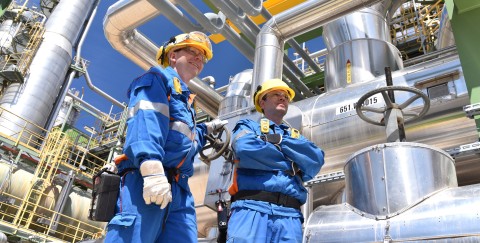What do hazardous incident officers do?
Ideally, they put themselves out of a job.
In her 15 years at Industriepark Höchst, Stefanie Stutzmann has only experienced a few events that merited the name “hazardous incident”. “Hazardous incident officer” – says the Team Leader for Process Safety at Infraserv Höchst – is a misleading term: After all, the job is not about creating hazardous incidents but rather about preventing them by identifying possible causes in advance and defining ways to eliminate them. She therefore prefers another term to describe what she and her colleagues do: “process safety engineer”.
The Regulation on Immission Control and Hazardous Incident Officers (5th Federal Immission Control Regulation, Bundesimmissionsschutzverordnung – BimSchV) is rather vague about the duties of a hazardous incident officer. It has to be. Companies are generally required to appoint a hazardous incident officer for "upper-tier establishments". These are, simply put, establishments where a defined minimum quantity of hazardous substances is stored, handled or processed. The actual substances and quantities are defined by the 12th BImSchV, also known as the Hazardous Incidents Regulation (Störfallverordnung – StörfV).
Obviously, the array of risks present in these establishments is as wide-ranging as the range of products produced there. Hazardous incident impacts range from environmental damage to neighboring rivers, etc. to hazards from toxic substances for employees and residents all the way to damage from fires or explosions.
Incidents can occur outside the actual processes, too. Common pain points include problems with connections to utility networks, which may manifest themselves as uncontrolled backflows or backfeeding, for example. Central exhaust systems can also cause problems. For example, different operators may introduce different substances that react with each other in an unforeseen, undesirable way in a completely different place.
Process safety engineers thus come from a wide array of backgrounds. In the chemical and pharmaceutical industries, they may be chemists or engineers: They have to give the plant operator guidance on key aspects of processes that pose relevant hazards – from the chemical reaction to the cleaning of the product to processes in metal processing plants such as electroplating or pickling plants. To perform their duties, hazardous incident officers have to personally inspect the facilities regularly – at least once a year. However, the operator always remains responsible for safety at the establishment. Hazardous incident officers have no control function and no authority to order the elimination of certain risks. Their function is to advise and support senior executives and plant managers. To do that, they must have an extraordinarily broad and diverse understanding of the underlying processes.
In her 15 years at Industriepark Höchst, Stefanie Stutzmann has only experienced a few events that merited the name “hazardous incident”. “Hazardous incident officer” – says the Team Leader for Process Safety at Infraserv Höchst – is a misleading term: After all, the job is not about creating hazardous incidents but rather about preventing them by identifying possible causes in advance and defining ways to eliminate them. She therefore prefers another term to describe what she and her colleagues do: “process safety engineer”.
The Regulation on Immission Control and Hazardous Incident Officers (5th Federal Immission Control Regulation, Bundesimmissionsschutzverordnung – BimSchV) is rather vague about the duties of a hazardous incident officer. It has to be. Companies are generally required to appoint a hazardous incident officer for "upper-tier establishments". These are, simply put, establishments where a defined minimum quantity of hazardous substances is stored, handled or processed. The actual substances and quantities are defined by the 12th BImSchV, also known as the Hazardous Incidents Regulation (Störfallverordnung – StörfV).
Obviously, the array of risks present in these establishments is as wide-ranging as the range of products produced there. Hazardous incident impacts range from environmental damage to neighboring rivers, etc. to hazards from toxic substances for employees and residents all the way to damage from fires or explosions.
Incidents can occur outside the actual processes, too. Common pain points include problems with connections to utility networks, which may manifest themselves as uncontrolled backflows or backfeeding, for example. Central exhaust systems can also cause problems. For example, different operators may introduce different substances that react with each other in an unforeseen, undesirable way in a completely different place.
Process safety engineers thus come from a wide array of backgrounds. In the chemical and pharmaceutical industries, they may be chemists or engineers: They have to give the plant operator guidance on key aspects of processes that pose relevant hazards – from the chemical reaction to the cleaning of the product to processes in metal processing plants such as electroplating or pickling plants. To perform their duties, hazardous incident officers have to personally inspect the facilities regularly – at least once a year. However, the operator always remains responsible for safety at the establishment. Hazardous incident officers have no control function and no authority to order the elimination of certain risks. Their function is to advise and support senior executives and plant managers. To do that, they must have an extraordinarily broad and diverse understanding of the underlying processes.
Process safety is based on many pillars
- Explosion protection: Explosion risks come from defective work equipment as well as human error such as incorrectly assessing current work conditions. The purpose of explosion protection is to identify and document potential causes of explosions and put appropriate systems in place to prevent them.
- HAZOP (Hazard and Operability Study): This is a systematic methodology that consists of systematically searching for possible issues, identifying causes, assessing possible impacts and taking action. These studies are used to conduct a risk assessment on the process plant as a whole.
- Safety management system: It covers testing, maintenance, hazard management and change management. A safety management system is required under the Hazardous Incident Regulation and must be audited independently (externally, etc.).
- Electrical, instrumentation and control: This involves protecting plants and measuring equipment with process control systems in order to achieve a defined safety integrity level.
Fortunately, the law does not require hazardous incident officers to come from within the company’s own ranks. Their job involves answering the question, “What could happen?” To provide the best possible response at any time, you have to possess the ability to see things that have not yet happened. And that requires thinking outside the box. Not to mention the ability to compare circumstances to similar risk situations at other companies.
In addition, Infraserv helps customers prepare the safety reports that the Hazardous Incident Regulation requires every operator of an upper-tier establishment to submit every five years or after changes to the facility. Our specialists also provide valuable services as sworn experts in any permitting procedures for new plants and upcoming audits. For obvious reasons, though, we can only do this if are not already serving as that customer’s hazardous incident officer.
Today, professional process safety management is more important than ever: A series of incidents in the 1980s prompted the introduction of strict standards that, at least initially, generally improved safety significantly. However, Stutzmann has noted that safety performance seems to be eroding overall. This might be due to a growing burden on plant managers as they take on more and more personnel responsibility alongside accelerated turnover.
This is another reason for companies to outsource more than just training and auditing. To ensure process safety, they should bring in professional hazardous incident officers who do this job full-time – instead of acquiring the entire swath of necessary knowledge alongside their regular duties – and so can contribute their experience from other areas. This frees up the company’s employees to focus on their actual duties.


